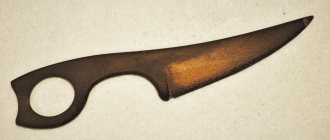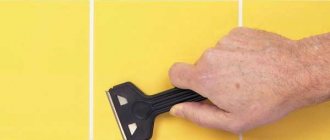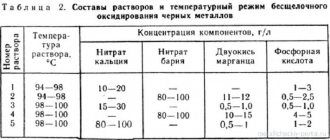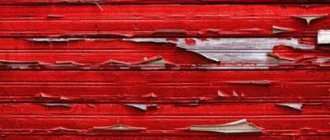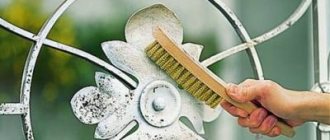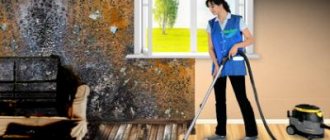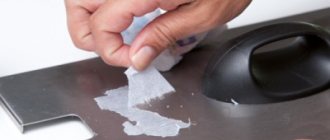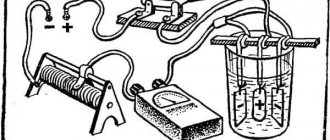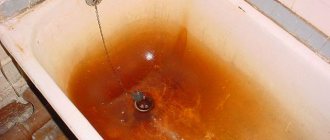The appearance of rust on metal surfaces and parts is a very common phenomenon that is often encountered not only by motorists. Corrosion is a chemical reaction that causes damage to metal. Cleaning rust from iron at home is one of the frequently asked questions that does not have a definite answer. In this material we will look at all possible ways to combat corrosion, and what tools, preparations and improvised means will be needed for this.
Chemistry
Corrosion is a chemical process, so why not fight it with chemistry?
In every hypermarket or household chemicals store you will find many different products that can clean rust from cast iron, metal objects, plastic, etc. You must take into account the need for longer exposure to the products, and because of their cost, they are more suitable for small areas. During use, strictly follow the instructions and safety recommendations. Gloves are a must when handling chemicals, as are open windows (it's best to use rust removers outdoors).
WD-40
WD-40 is an anti-corrosion lubricant recommended for home removal of rust on metal and other materials. This product can be used to clean tools, garden equipment, cars, toys, furniture, and cauldrons from rust.
After use, the lubricant dries instantly and protects the metal from corrosive particles. It keeps the surface dry for a long time and prevents the reaction of water with metal.
WD-40 should be applied after removing rust from the surface. The product penetrates deeply into the surface, releasing rusty metal particles, therefore, remaining dirt can be easily wiped off.
Conversion
A modern method for processing rusty objects is conversion. It's about turning rust into a state that doesn't damage the metal. The products are produced in the form of a lubricant or spray.
Formalin
Rust from stainless steel is washed with the following mixture dissolved in 1 liter of water:
- formalin – 200 g;
- ammonium – 55 g;
- caustic soda – 53 g.
Place nails, nuts and bolts into the resulting cleaning solution and leave until the rusty coating is removed (up to 30 minutes). Rinse with water.
Why does rust appear?
Metals are subject to rust due to the fact that they are not mined and used pure, but in the form of chemical compounds with oxygen, carbon, water, sulfur and other elements. Corrosion is not a problem for pure metals, since they do not tend to form compounds with environmental substances. However, there are few such materials - silver, gold and platinum.
There are a huge number of different ways to remove rust from metal, but not all of them work as desired.
Most mined contaminated metals are smelted, purified, and reduced to make them pure. However, in this case they become unstable and tend to react with environmental elements. Thus, when a metal comes into contact with air, an oxide is formed, and with moisture, a hydroxide is formed. These processes are natural for iron and are called corrosion, and their result is rust.
Even if you can’t remove the rust the first time, with some effort you can always return the item to its original appearance.
Since metals are mainly used as durable materials, which are the basis for various structures, they are constantly in contact with the environment and the corrosion process is inevitable. If air oxygen and moisture are constantly present, then after some time the iron can be destroyed to the ground, completely converted into rust.
There are various ways to remove corrosive plaque if the process has not gone too far.
However, corrosion is not a very fast process, so iron products are destroyed over a fairly long period of time. In addition, new methods are being invented to delay the appearance of rust as much as possible.
Note! High-quality removal of rust from a metal surface is one of the most effective ways to preserve a product in proper condition.
However, rusty deposits can often be present on various non-metallic surfaces such as tiles or bathtubs. This occurs due to rusting plumbing fixtures and other equipment with metal elements that are exposed to the environment. Rust is then carried by water, contaminating surfaces in addition to limescale. However, all such coatings are quite easy to clean.
Household chemicals are the most effective means for removing rust.
It is worth removing rust in the following cases:
- Before gluing or painting metal products. Traces of corrosion will not allow glue or paint to firmly adhere to the metal surface, and therefore they must be removed.
- To protect against destruction. In order for a metal product to last a long time, it must be promptly cleaned of iron oxides and coated with anti-corrosion materials such as zinc oxide.
- For aesthetic reasons.
How to remove rust from metals
Removing rust is a rather labor-intensive process, as it will require a lot of effort and time. Despite the availability of automatic means and expensive chemicals, it will not be possible to remove all the rust quickly.
In this chapter, we will pay special attention to the issue of how to remove rust at home using improvised means. https://www.youtube.com/embed/DFngjz8eKGA
The most popular and frequently used remedy is vinegar. If the part is small, then you can simply put it in a vinegar solution. If the item is large, then you need to make a compress from acetic acid - soak a rag in vinegar and put it on the metal. Wait a while, at least an hour, then clean with sandpaper or a wire brush. After cleaning, you can repeat the soaking.
Rust is removed in a similar way using other chemicals: oxalic acid, salt mixed with lemon juice. The purpose of these activities is to soften the rust so that it can easily come off the metal. It will not be possible to completely dissolve it.
Mechanical removal
Since corrosion products have low adhesion, they are easy to remove from the surface of the product by mechanical action. This method is convenient for removing rusty deposits from large, smooth metal surfaces. It is also advisable to use this method for cleaning heavily rusted products as the first stage of completely removing contamination.
The mechanical method includes removing rust using special brushes, grinding wheels, and sandpaper.
To clean large items, you can use a grinding machine, starting with the coarsest grains and finishing with the finest grains. Metal brushes and abrasive attachments for an angle grinder or drill are also suitable. It is more convenient to clean small parts with sandpaper.
Products with complex geometry are difficult to mechanically influence, so it is more effective to use other methods for them.
Note! The areas of metal treated in this way remain without protection from the environment, and therefore, without special treatment, they will become covered with rust even faster.
Thermal cleaning of steel surfaces
To implement this method, you will need an industrial steam generator or, in extreme cases, a construction hair dryer. In this case, cleaning is based on the fact that the combination of scale of any chemical composition with the base metal is relatively small. Therefore, exposure to temperature, moisture, and changes in air flow speed will help remove surface rust.
The most effective cleaning using this method occurs if the surface to be treated is placed at some distance from the unit and the heated steam supply is turned on. A jet of steam-air mixture supplied under pressure first softens the scale and then crushes it into separate fragments, which are subsequently easily removed by an air stream.
In this way, you can remove rust from the surface of a steel door, ventilation duct, and other metal objects, the dismantling of which is either difficult or completely impossible.
Heat treatment
Heat breaks down rust and is easy to remove with regular cleaning. Therefore, to combat the scourge, you can use the following tricks:
- if possible, pour boiling water over the object, wait for some time (until it cools down a little) and remove the loose layer;
- You can heat the device over a gas burner, gradually removing the easily removable deposit. To make the process faster, first apply hydrogen peroxide to the part;
- For those who have a steamer or steam mop at home, it's even easier: treat the rusty area with an intense stream of steam and scrub.
Causes of rust
Rust is the outward manifestation of metal corrosion as a result of the chemical process of oxidation. Outwardly it looks like a brown-red formation. Of all the metals, iron and its alloys are the most susceptible to corrosion. Even stainless steel, despite its name, can also rust.
Corrosion spots can cover the metal surface completely, or form locally in individual areas. It is not easy to remove rust from metal; it is much better to prevent its occurrence. If measures are not taken in time, over time the plaque can completely destroy the product.
When choosing tools made of stainless steel, remember that this material is also susceptible to corrosion and you need to monitor the products no less carefully than items made from other metals
At home, the main reasons for the appearance of traces of corrosion are constant exposure to water and high air humidity. The most susceptible to the formation of oxides are those objects that are located on the street: window grilles, iron door visors, padlocks, chains, pipes, etc.
At home, rust is most often found in areas with direct access to water, such as the bathroom and kitchen. Often, corrosion stains can be found on water faucets, chains or places of their attachment, on pipes.
Plumbing pipes are most susceptible to corrosion due to constant contact with water
Rust may be one of the reasons for the annoying squeaking of door hinges in your home.
It is important to understand that in addition to external discomfort, a coating of corrosion on hinges significantly increases their wear
Corrosion stains can significantly degrade the appearance of the product and shorten its service life.
Causes of metal rusting and why it is dangerous
Rust spoils the appearance and interferes with the normal functioning of products
Rust is the final stage of metal oxidation. The corresponding chemical reaction occurs when the material comes into contact with water (even droplets of moisture in the air are sufficient). The main danger of rust is its destructive effect on metal products, including their appearance. Gradually the material becomes covered with holes and rots. Metal mechanisms become unusable and do not function correctly.
One of the causes of corrosion is damage to the protective coating.
The spread of corrosion is influenced by:
— chips and defects in the paintwork;
— cracks and scratches on the material;
— lack of anti-corrosion treatment.
Unusual ways
You can remove traces of corrosion using unusual but effective methods.
Coca Cola
You can quickly get rid of unpleasant traces of metal oxidation from a stroller, household utensils, and even a car body with the help of a popular drink - Coca-Cola. Soda should be poured into a plastic tray or container, and then items damaged by corrosion should be placed in it. Usually a few hours are enough for the drink to corrode even severe rust.
Soda can be used to remove rust from a circuit board or other delicate products. In this case, you need to soak a rag or sponge in Coca-Cola and wipe the surface. Repeat the action if necessary.
Ketchup or tomatoes
If there are expired canned tomatoes or ketchup in the refrigerator, do not rush to throw them away, as they can be used to clean metal from red marks. To eliminate them, just apply ketchup, tomato paste or tomatoes on them and leave for 20 minutes. If the damage is severe, the treatment time can be increased. Afterwards, you just need to wash everything well to remove traces of food.
Electrolysis
If a wash or folk remedy is not effective enough, electricity can be used to solve the problem. You need to follow the algorithm of actions:
- Pour warm water into a plastic tub or tray.
- Add a couple of tablespoons of salt or baking soda.
- Take a car battery charger.
- Screw a metal plate to one terminal.
- Connect the part from which you want to remove rust to another wire.
- Dip both ends into the prepared solution and apply current, setting the current to 4-6 amperes.
- Leave for 30 minutes or more.
- Remaining traces can be easily wiped off with a brush or rough sponge.
Choose the right option to remove rust from damaged metal and restore its aesthetics or functionality. To prevent the problem from returning, protect the surface with primer, paint, varnish, oil or another product.
Effective rust remover - video:
How to remove with acid
Acid is the main component of many commercially prepared rust converters. Only there are some additives in the composition, but at home it is quite acceptable to get by with a clean solution. You will need:
- One of the acids (phosphoric, oxalic, citric).
- Water to dilute the solution to the required concentration.
The finished composition will cope with pitting and focal corrosion of metal without any problems.
Sorrel
The acid contained in the plant of the same name is sold in stores in a dry state, in the form of white crystals. To obtain a working solution, the powder must be diluted in water, avoiding contact with the skin, mucous membranes, and organs of vision. It is strongly recommended to use protective equipment when working with acids: goggles, overalls, gloves.
To prepare the working solution you will need 5 teaspoons of powder, as well as 250 milliliters of clean water. The crystals are stirred until completely dissolved, then immersed (or coated with a soft brush) on the workpiece. After about half an hour, depending on the degree of oxidation of the metal, the product is washed and then wiped dry.
Orthophosphoric
Phosphoric acid is part of rust converters and is used to remove corrosion products of ferrous metals
It must be used with caution to avoid burns. The composition is applied dropwise, using a brush, to large areas - with a paint roller or spray gun.
If proper protective measures are taken, acid does an excellent job of cleaning parts and metal surfaces from oxides.
Lemon
Food “lemon” also refers to acids. A bag of reagent is poured into warm water or immediately onto the part being processed, and then diluted to a mushy state - whichever you prefer. The effect of using citric acid will be no less strong than that of other solutions. At the end of the procedure, the metal is cleaned of corrosion residues, washed and wiped dry.
Types of processing of rusty metal surfaces
The choice of rust treatment method depends on the degree of corrosion and the type of item itself.
It is also necessary to consider what metal care products are available and available for use. The most common processing methods include:
- Chemical.
- Mechanical.
- Thermal. It is carried out using a torch.
Rust cannot be removed by washing with plain water. For this purpose, targeted, comprehensive processing is required.
You will find all the most useful and important information about rust removal methods and techniques in this section.
Thermal
The thermal method is rarely used . The use of an oxygen-acetylene torch makes it possible to remove mill scale well, but does not completely remove rust.
Mechanical
Physical impact on rust is designed to remove the top layer of material that has become loose. This can be done in several ways:
- manually (using a brush with metal bristles and scrapers);
- using a grinding machine or a special machine.
In addition to those products that are available at home, industrial enterprises also use serious devices using special equipment to treat rust:
- shot blasting;
- water sandblasting;
- sandblasting
The best result is obtained by a combination of abrasive and chemical effects.
Chemical
Chemical treatment is carried out using homemade products and purchased, ready-to-use preparations. In addition, large metal surfaces are also subjected to special influences that help preserve and protect the material:
- connection with organic additives, providing bluing;
- cementation - a chemical reaction with carbon;
- nitriding, etc.
Treatments carried out at home include:
- preparation of material;
- exposure to a chemical;
- wash.
The type of chemical exposure must take into account the degree of damage to the metal.
How to remove rust from coins?
Before you begin the corrosion removal procedure, you need to take into account several recommendations:
- The following acids cannot be used to clean coins: hydrochloric, sulfuric, nitric and acetic. They can spoil the design or compromise the integrity of the coin's surface.
- Do not use metal brushes or sandpaper.
- Do not heat the metal until it is completely hot.
- Determine the alloy composition by choosing the most appropriate method.
Method 1
To remove corrosion from a regular iron coin, proceed as follows:
- Take a weak solution of hydrochloric acid.
- Gently wipe the coin.
- Clean the surface with brass wire or a needle.
- Rinse the coin under the tap.
- Wrap in cloth and wait until the product dries.
- Rub with felt until shiny.
Method 2
Cleaning copper and bronze coins:
- Wet the coin under the tap.
- Rub the product with vinegar or citric acid.
- Rinse in warm water.
- Wrap in cloth and let dry.
Method 3
The following method can be used to clean low-grade silver coins:
- Buy a silver cleaner at a jewelry store.
- Clean according to the instructions for use.
- Wipe with a soft cloth to restore the coin's shine.
Method 4
Cleaning fine silver coins:
- Pour ammonia into a small container.
- Immerse the coin in the liquid and leave it for 1 hour.
- Take out the coin and wrap it in a moisture-absorbing cloth.
Method 5
Cleaning a coin made of gold:
- Dissolve 30 grams of laundry soap in a liter of water.
- Immerse the coin in the solution and wait a little (you can increase the effectiveness of the method by slightly heating the water).
- Rub the product with your fingers.
- Remove the coin from the soapy water and wrap it in a cloth.
- Leave to dry.
Chemical solvents, corrosion converters
If you are thinking about how to clean rust from tools in the shortest possible time, buy special liquids designed to eliminate corrosion. Similar products can be divided into two categories:
- solvents (provide rust softening);
- converters (designed to create a protective layer).
Solvents
The best rust remover included in this category is “Rust Neutralizer VSN-1”. It works quickly and effectively. The price of this product is quite affordable, allowing it to be purchased by a wide range of consumers. After the product is applied to the product, the rust changes structurally and dissolves. After a certain period of time, which is prescribed in the manual, it is possible to easily clean the metal from rust using an ordinary cloth.
Typically, such products include phosphoric or oxalic acid. When interacting with such tools, follow safety rules. Once on the skin, the acid can seriously burn it.
Converters
The converter forms a special film that stops the corrosion process that has begun and prevents reoccurrence. It is produced in the form of a solution, suspension, or emulsion liquid. Often such products are made from a phosphorus-based acid, tannin. Before applying the liquid, remove loose flakes and dust using a metal brush or sandpaper.
How to remove rust from metal? Make a special "cocktail". It should include:
- one liter of phosphorus-based acid solution;
- fifteen milliliters of tartaric acid;
- five milliliters of butanol.
Special anti-corrosion agents
There are several special products that are produced to combat corrosive plaque.
Solvents
To remove rust from metal coatings, use Schnell-Rostloser. This cleaner has good qualities that allow you to get rid of traces of oxidation. You can also treat the iron product with Spirit-1 solvent. Its advantages include:
- displacement of moisture particles from iron;
- formation of a protective layer on the treated coating;
- cheapness.
See also
How and what is the best way to wash windows correctly and quickly at home without streaks
Converters
Converters are means that convert corrosion particles into a durable film. Such compositions are available in the form of solutions, emulsions and suspensions.
Experts recommend using converters not only to remove rust stains, but also to protect the product from further corrosion.
Homemade rust removers
Rusty-brown stains on an iron surface not only make the product unsightly in appearance, but also have a destructive effect, tending to turn durable shiny metal into flakes. As soon as you leave baking sheets, frying pans, and cutlery wet, they immediately fall under the gun of the “red enemy.” Experienced housewives know what available substances can cope with this serious problem. Here are some of them.
Vinegar
The product affected by corrosion is placed in a container with 9% vinegar and left for 10–15 hours, after which the remaining dirt is removed with a stiff brush, washed with running water and wiped dry.
If the product is too bulky and it is impossible to soak it entirely, vinegar is applied with a brush or sprayed.
Soda
Pour a handful of baking soda into a bowl and dilute with water until a thick paste is obtained. Using a sponge or brush, coat the rusted part with the prepared product and leave for half an hour, after which it is thoroughly cleaned with an iron wool or brush, washed with water and wiped dry.
Salt and potatoes
To remove fresh rust stains, many people use salt and a potato tuber cut in half. Potatoes contain oxalic acid, which will corrode plaque, and salt acts as an abrasive.
The cleaning process is incredibly simple. Sprinkle the potato cut with salt and rub a metal object, such as a knife or baking tray, until the rust marks disappear.
Kerosene
The most famous substance that allows you to quickly remove rusty stains. The damaged surface of the part is cleaned with a metal brush, wrapped in a rag soaked in kerosene and left for 2-3 hours.
Fish fat
If fish oil is available on the farm, it can be used to solve rust problems. Thanks to this product, the surface will not only get rid of corrosion, but will also gain protection in the form of a thin fatty film remaining after applying grease. The cleaning method is similar to those described above: coat the affected area with fish oil, leave for 2-3 hours, after which the remaining rust is removed.
Inquisitive housewives have discovered a lot of substances that can remove rust stains and restore the appearance of a metal product. It turns out that tomato ketchup, Coca-Cola, and even some medications, such as Alka-Seltzer or aspirin, do an excellent job of this. The main thing is to thoroughly dry the surface after cleaning and wipe iron objects dry each time after use and store them in a dry place.
Preventing rust
To protect metals from rust, various alloys are created. Thus, chromium, molybdenum, nickel, sulfur, titanium and other elements are often added to the composition, which are responsible for certain properties of the resulting alloys. However, this method is not always acceptable and is also quite expensive.
A stainless alloy is formed if the chemical composition contains more than 13% chromium.
A more convenient option is to apply coatings to existing metal, forming a barrier between the surface of the product and the environment, which helps slow down the corrosion process. Paints or primers are often used as a coating, but the most effective option is to apply a thin layer of another metal that rusts very slowly. For example, iron can be coated with chromium, tin, copper or nickel. At the moment, zinc is considered the most optimal option, combining ease of application, low cost and high efficiency. It corrodes three times slower than the vast majority of metals and, when applied correctly, can completely stop corrosion for 25-30 years.
Galvanizing is a coating of metal with a layer of zinc to protect it from corrosion.
A rusty coating eventually affects almost any metal. However, with timely cleaning and treatment, the service life of the product can be significantly extended.
You can remove rust stains from any metal surfaces.
Vinegar cleans metal from rust and oxides
This product will definitely be found in any kitchen. To achieve ideal cleaning results, it is better to use white vinegar. A metal rust remover effectively cleans it without compromising the integrity of other surfaces.
- Pour white vinegar into a container large enough to fit the spoiled item.
- Immerse the product in a container with product. Do not dilute the solution.
- Leave the item in the container of white vinegar until the corrosion has weakened enough to be easily removed.
- Put on rubber gloves, remove the product from the solution and clean with a wire brush.
- Rinse the metal well, then dry.
In fact, the whole process goes very quickly, because while the metal is soaking, you can do laundry or spend time with your loved ones.
Preventive actions
To protect metal from corrosion, you can perform a number of preventive procedures:
- After moisture gets on a metal surface, wipe it dry with a cloth.
- Store metal products in areas with low humidity.
- If you need to paint a surface, first of all, it needs to be cleaned of the old decorative layer. Then remove dirt, degrease and apply primer. Only after the primer can a coat of paint be applied.
When removing rust, you can combine several methods.
This will increase the cleaning efficiency. People who do metalworking, repair cars, or work with metal tools need to know how to clean the material from corrosion. It is not necessary to use special equipment for this. It is enough to use available means.
Methods for removing rust at home
How to clean rust from metal? This question has been asked by many people for a long time. There are various folk methods that make it possible to remove rust from metal at home. The effectiveness of such methods does not allow them to cease to be popular. It is possible to remove rust from both metal and fabric.
Table acetic acid
Vinegar is an excellent way to combat corrosion. It dissolves brown plaque flakes. If you need to remove rust from a small item (coin, knife, pliers, key, jewelry), keep it in table acetic acid for a couple of hours.
After the crusty layer has softened, remove it with a crumpled piece of aluminum foil. It has enough rigidity to remove rust from metal. At the same time, the foil does not deform the coating of the object, which cannot be said about a metal brush.
If rust appears on a large object (hacksaw, shovel, ladder, fittings), you need to thoroughly wet a cloth with acetic acid and wipe the rusted parts with it. After some time, the plaque will soften and it will be possible to remove rust from the metal using a special brush.
Lime and salt
Acid with salt is deservedly considered one of the best rust removers. This is the second most common method of eliminating rye and stopping the corrosive effects. Cut the lime in half and squeeze as much juice as you can onto the rusty parts. Sprinkle the soaked areas with salt.
Don't throw away the lime peel. It will serve as a “sponge” that removes softened rust. After two hours of etching, try to scrub off the corrosion. If it does not give in, wait a while. You can use lemon juice instead of lime, but lime will help dissolve the problem much more effectively.
Soda
Make a baking soda mixture by mixing baking soda with water. Clear proportions are not defined. The mixture should be similar to rich sour cream or toothpaste. The finished mixture is placed in a thin layer on the rust and waited for two to three hours.
Do not think that after this period the corrosion will disappear and the metal will shine. To remove rust from metal, use a toothbrush and a piece of aluminum foil. After treating the rust, corrosion will be eliminated.
Potatoes and laundry soap
Using a similar method, it is possible to remove rust from metal at home, both small and large things. The potato tuber must be cut in half, and the cut should be wiped with laundry soap. After this, place the potato on the rusted part. When in contact with soap and potatoes, corrosion starts a chemical reaction. After a couple of hours, you can try to wash off the brown deposits with a stream of hot water.
Lemon acid
Make a solution of citric acid (three packets per liter of water). Boil the finished mixture and turn off the gas stove. Place rusty things (screwdrivers, pliers, screws, nails, etc.) in boiling water. You will immediately see the liquid in the container bubble. Treating rust by soaking requires at least eight hours. Softened rust is removed with a brush or sponge.
Oxalic acid
It is necessary to remove rust from metal before painting in a ventilated area. Be careful! Use rubber gloves, special glasses, and a robe. If acid gets on your skin or eyes, you will get very severe burns.
To remove rust at home, make a solution (four tablespoons of acid per glass of warm water). Before soaking the product, wash it with dishwashing detergent and dry it. For the rust to dissolve, the metal object must lie in the mixture for at least thirty minutes. After this, you can try to remove the rust with a toothbrush, which is not needed.
Upon completion of cleaning, wash the metal item with a powerful stream of hot water and dry it well with a napkin.
Features of removing corrosion from various objects
Removing rust from various objects has certain features that must be dealt with in advance.
From the body of a car
Motorists often have to remove traces of corrosion from the body of their vehicle. To do this, use the following anti-corrosion compounds:
- Orthophosphoric acid. A solution of orthophosphoric acid will help remove rust from iron. It is applied to the surface of the sponge that will be used to wipe the car body.
- Zinc. Mixtures prepared from zinc remove corrosive plaque after the first treatment.
Water tap
You must clean the faucet in the kitchen or bathroom very carefully so as not to accidentally damage its coating. You can wash a metal enameled surface with the preparation “Adrilan”, which is produced for washing household appliances. Before use, it is mixed with warm water to make the composition less concentrated.
Bicycle
If you don't take care of your bike, sooner or later rusty spots will appear on its frame. When cleaning a bicycle from corrosion traces, use citric acid. To remove rust, perform the following sequence of actions:
- degreasing the surface and sanding it;
- surface coating with acid;
- washing the treated area.
Konkov
When skates are stored for a long time in conditions of high humidity, a rusty coating forms on them. Experts recommend eliminating it with folk remedies. A mixture made from baking soda and lemon juice is considered effective. To prepare the cleanser, mix lemon juice with baking soda until a paste-like mixture is obtained. It is rubbed into the rusty surface and washed off with water after an hour and a half.
Horseshoes
An old rusty horseshoe can be cleaned with oxalic acid. To create a working solution, you need to mix a kilogram of acid with 12-14 liters of boiled water. Then the liquid is poured into a separate bucket, after which a horseshoe is lowered into it for forty minutes.
Oxalic acid emits dangerous fumes and therefore wear a protective mask when handling it.
Instrument
Files and other metal tools that are rarely used will rust over time. You can clean working tools from corrosive deposits with a vinegar solution. Vinegar is mixed with water in a one to one ratio, after which the prepared solution is poured onto the tools. Then they are scrubbed with a wire brush and washed.
Nuts
Cleaning nuts from rusty deposits is quite simple. To do this, pour 100 milliliters of vinegar into a bucket of water. Then add all the rusty nuts that need to be cleaned. They are soaked for at least 3-4 hours, after which they are washed with water and wiped off any remaining rust stains.
Cleaning small household items
Keys and other small household items may develop small rusty spots. You can get rid of them using both chemical and mechanical methods.
Folk remedies for removing rust from metal
In addition to chemical toxic substances, there are no less powerful folk remedies for removing rust from metal. Traditional cleaning agents include potatoes, soda, citric acid and vinegar.
How to get rid of rust on metal with potatoes
This may seem unexpected to many, but people have long realized that such everyday potatoes will be able to cope with traces of corrosion with a bang.
Thanks to the chemical properties of potatoes: we ate it and washed the metal!
You will need one potato and laundry soap: cut the tuber into two parts and soap the cut, which will help deal with the rusty surface. It is best to leave the potatoes in the damaged area for 3-4 hours.
During this time, you can trim the same tuber, soap the cut again and place the potato on the rusty place. And some also prepare a special liquid for removing rust from metal from potato tops - it becomes a kind of inhibitor.
Green tops will do when they are still juicy
All greens need to be placed in a 3-liter jar - halfway. Add hydrochloric or hydrochloric acid into it so that it lightly covers the tops. For 15-20 minutes we feel like sorcerers, stirring the potion. And then the liquid is drained into another container: it can be used for anti-corrosion treatment.
How to remove rust from metal at home using citric acid or lemon juice
A package of citric acid costs literally pennies; you can buy this miracle at any grocery store or supermarket in the “spices” or “baking supplies” department.
One pack is enough to treat minor corrosion damage
One package is poured into a container and filled with such an amount of water that will allow the entire item to be cleaned to be immersed in it. The reaction will be indicated by bubbles rising to the surface. The container is left untouched for 12-13 hours. Then the item is removed from the solution, rinsed and dried.
The second way is to use fruit acid in its natural form: you can take lime and salt
Sprinkle salt on the rusty spots and squeeze the juice from the fruit onto them. There is no need to save: the more the surface is wetted, the better the result. It is better to leave the soaked object for 3 hours, and after that clean it with the peel of a lime or lemon.
How to remove rust from metal with soda
Soda has become so firmly established in our everyday lives that there are funny memes and jokes about it on the Internet.
But this surefire remedy is always at hand
This time, the household assistant will show its superhero strength not in the kitchen, but in the fight against rust that corrodes metal products. All you need to do is mix baking soda with a small amount of water until a paste forms. The mixture is smeared over the damaged area and after a while, everything is cleaned with an old toothbrush.
How to remove rust? It's good to have soda!
Vinegar as a rust remover from metal
Vinegar is also on the shelf in almost every kitchen. It simply eats away the rust itself, which is why it is an excellent anti-corrosion agent.
Acetic acid will also work
White vinegar reacts well with corrosion, removing all rust marks on metal. You can simply dip the item in vinegar and leave it there for 2-4 hours. The rusty paste is simply scraped off and the item is rinsed and dried.
What to do if the item turns out to be large: vinegar is poured into a flat container like a baking tray - you still have to pickle the item. If the damage to the metal is not severe, it is easier to simply soak a cloth in vinegar and thoroughly wet the object.
How to clean with special compounds?
Purchased anti-corrosion treatment products have a rich composition containing active substances in high concentrations . These drugs will help in cases where there is advanced corrosion with serious damage to the metal, covering a significant area or the surface of serious equipment, for example, a car, is damaged.
Products can be either acid-containing or acid-free. In addition to the main active ingredient, the finished products include corrosion inhibitors, thickeners and other additional components.
Before using the converter, the surface must be prepared:
- eliminate contamination;
- clean off loose layers of rust;
- degrease the surface.
Hi-Gear Rust Treatment
Hi-Gear is a rust converter that can cope with even advanced corrosion, as it penetrates even into the deep layers of the material. The drug is applied by spraying. As a result of a chemical reaction, rust is eliminated, and a polymer protective composition is formed on the surface.
The use of Hi-Gear requires caution , since the composition is capable of reacting not only with corrosion products, but also with the paintwork. After exposure to the converter, it must be washed off using alcohol-based solvents.
Despite the high price for the bottle, the purchase can be considered profitable, since the consumption of the product is very economical. The price of the package is about 700 rubles.
Phenom
Hairdryer is a rust converter that is often chosen by car enthusiasts. The product is well distributed on the surface and creates a dense polymer layer. The drug is a reliable means of preventing relapse of corrosion at the treatment site for many years.
The hairdryer comes in a compact black package and is a white liquid . Due to the small volume of the product in one bottle, several bottles may be needed to treat a large area of metal.
One of the main disadvantages is the small volume. When purchasing several bottles, the cost of processing increases significantly.
Pros of use:
- efficiency;
- affordable price for 1 bottle;
- a protective layer is created;
- quick and easy application - brush application;
- high-quality metal processing through complex influence.
The price of a small bottle is about 150 rubles.
Kudo KV-70005
Kudo is a structural modifier that effectively combats rust due to the presence of acids. The drug can be used to eliminate small areas of corrosion. The product is packaged in small bottles and is conveniently applied with the included brush.
Due to the fact that the Kudo composition does not react with varnishes and paints, it can be safely used on equipment, including body work. After application and reaction, a protective film of zinc is created on the metal surface.
Price for 15 ml - 120 rubles.
